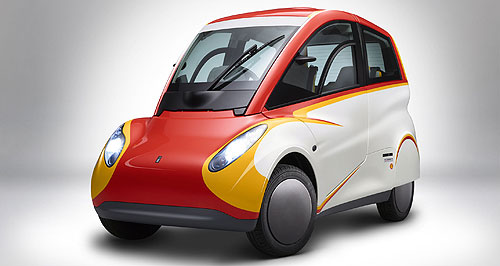Make / Model Search
Future models - Shell - Concept CarShell car returns 2.6L/100kmThree-up: Gordon Murray's latest road model makes an hommage to his first with an unorthodox but unmistakable three-seat layout. Petrol giant explores potential of low carbon footprint cars with Shell Concept CarGallery Click to see larger images 27 Apr 2016 WHILE almost all the world's mainstream automotive brands are embracing electrified powertrains in some form, multinational oil and gas company Royal Dutch Shell is still pursuing petrol's potential with a 550kg concept car that can return fuel economy of 2.6 litres per 100km. With the partnership of Gordon Murray Design and the designer of the McLaren F1 supercar, the petrochemical manufacturer has produced the Shell Concept Car which, it says does not just burn less fuel in operation, but also requires less energy in all stages of its life. According to Shell, the micro car is “proof of energy efficiency improvements that can be achieved by using cutting edge technology available today through a process of co-engineering whereby vehicle body, engine design and lubricants are all created together”. The tiny car is an evolution of Gordon Murray Design's T.25 of 2010, which uses a 38kW 660cc three-cylinder petrol engine coupled to a five-speed gearbox, but for the new car a “total rethink” has stripped 25kg from the car, while a specially “designed” Shell oil has boosts engine efficiency by five per cent. It is assumed Shell also provided the fuel for its purely combustion-powered drivetrain, which was “optimised” by Swiss motorcycle engine manufacturer Geo Technology. Construction materials were selected for their lightweight but strong attributes, as well as low cost and low energy dependence. These include recycled carbon-fibre for the bodywork. The car can be almost completely recycled at the end of its service life. With its focus on low CO2 footprint in all stages of construction, operation and disposal, the company says its concept reduces primary energy use when compared with a typical United Kingdom city car, and as much as 69 per cent compared with a popular SUV. Fuel consumption and CO2 emissions were independently tested under the New European Driving Cycle (NEDC) practice with just 4.69g released per kilometre – 28 per cent lower than a micro car and 32 per cent less than a typical hybrid says Shell. While the tiny vehicle adopts the typical tall and narrow stance of an economy-focused car, it does incorporate one nod to its designer's most famous car – the McLaren F1, with a three person seating arrangement that situates the driver slightly ahead of the two rear passengers. There are no plans to put the bantamweight car into production, but even if a showroom version was to be offered, the centrally-mounted driver's seat which prevented the F1 being sold in Australia would likely rule out the Shell Concept Car also. Shell lubricant research team vice president Andrew Hepher, said the concept championed the pursuit of lower carbon footprint manufacture and motoring. “Our car may be small, but it’s packed with potential. We want to accelerate the conversation about how we make road vehicles more energy efficient and less carbon-intensive,” he said. “In the coming weeks and months, we look forward to sharing our research insights from this project with engine designers, car manufacturers, academics and other experts across the automotive sector.”  Read more17th of February 2016  Riversimple Rasa revealedRasa turns out not to be monster Riversimple hydrogen supercar26th of September 2011  Gordon Murray ‘does a Tesla’ with Teewave AR.1Carbon-fibre electric sportscar weighs just 850kg – but iMiEV motor no Tesla-beaterAll future modelsMotor industry news |
Click to shareShell modelsAll future modelsMotor industry news |









 Alfa Romeo
Alfa Romeo Abarth
Abarth Audi
Audi Aston Martin
Aston Martin BMW
BMW Bentley
Bentley Ferrari
Ferrari Chevrolet
Chevrolet Ford
Ford Fiat
Fiat GWM
GWM Foton
Foton Hyundai
Hyundai Honda
Honda Jaguar
Jaguar Isuzu
Isuzu Kia
Kia Jeep
Jeep Land Rover
Land Rover Lamborghini
Lamborghini Maserati
Maserati Lexus
Lexus McLaren
McLaren Mazda
Mazda Mercedes-Benz
Mercedes-Benz Mitsubishi
Mitsubishi Mini
Mini Peugeot
Peugeot Nissan
Nissan Ram
Ram Porsche
Porsche Rolls-Royce
Rolls-Royce Smart
Smart Skoda
Skoda Suzuki
Suzuki Subaru
Subaru Toyota
Toyota Tesla
Tesla Volvo
Volvo Zeekr
Zeekr







Facebook Twitter Instagram